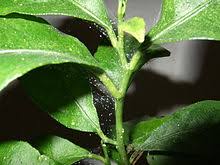Spider mites are common garden pests that feed on shrubs, trees, flowers, vegetables and even houseplants. These miniscule pests cause damage by bruising the plant’s tissues as they feed leading to mottled, brown foliage. Spider mites are difficult to see to the naked eye, but their presence can be detected by webbing on a plant and brown, mottled or dirty-looking foliage. To confirm the presence of spider mites, try holding a sheet of plain white paper below suspect plants. Tap or flick the foliage above the paper. Using a magnifying glass or the naked eye, watch for any tiny specs that move. These are mites. Outbreaks occur under hot, dry conditions and can seriously injure or kill a plant. There are a few ways to control spider mites:
- Hosing: A strong jet of water can destroy webbing and knock down spider mites populations.
- Beneficial Insects: Ladybugs, sold commercially, can be released underneath mite-infested plants to feed on mites.
- Neem Oil and Pyrethrins: These are typically combined in a multipurpose spray such as Safer™ brand 3 in 1 Garden Spray. Always follow the directions on the label.
- Horticultural Oil: This is possibly the best control available for the home gardener. The oil suffocates the eggs and the adults. Always follow the directions on the label.
- Avoiding strong insecticides containing imidacloprid that kill mite’s natural enemies will help avoid mite infestations by keeping the beneficial insect population higher.
Maintaining healthy plants will also help avoid mite infestations. Plants stressed by drought, crowding or lack of nutrients are prone to insect problems.



